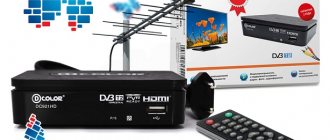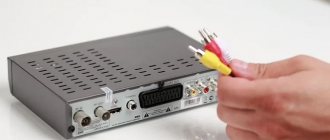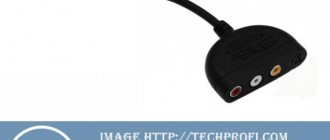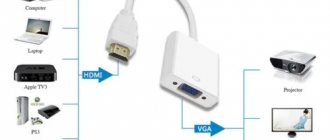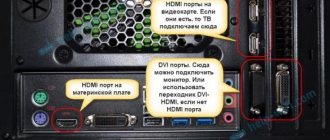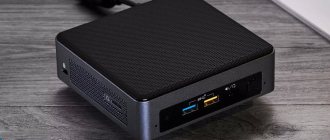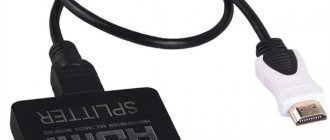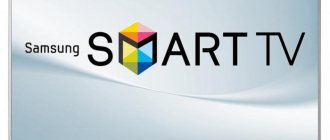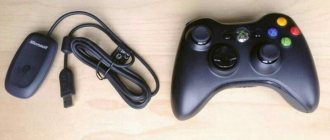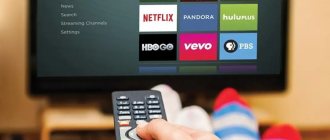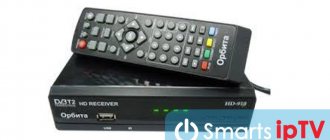Hi all! As promised, I continue the description of how to connect the phone to the TV. In a previous article on this topic, we already wrote about some methods, namely, about what is needed and what to expect from connecting in the USB format - USB or HDMI-HDMI. But these can be said to be already outdated methods. They have been replaced by MHL and SlimPort formats, as well as wireless connection methods.
In this article we will look at another connection method, using a special adapter, what do you need to know so as not to waste money in vain?
What is a USB/HDMI adapter and its use?
A USB to HDMI adapter is an independent device that converts digital files into video and transmits the image to a TV screen or PC monitor.
In fact, this device can no longer be called an accessory, but a gadget - after all, it performs a separate job, and not only acts as a switching device. IMPORTANT ! Now we are only talking about transferring a video stream from a computer with a USB port (or a smartphone with mini/micro USB) to a TV or monitor equipped with an HDMI port, but not vice versa, because it is not possible to load the necessary drivers into the TV.
This is what such an adapter looks like, although modifications may vary
How it works?
You need to understand that both USB and HDMI are physical interfaces that transmit digital, not analog, data. However, they convey different types of information. Most likely, without special software, you will not be able to transfer a file from one device to another via HDMI, just as you cannot transfer sound directly using a USB connection. Therefore, before purchasing such an adapter, you need to search for suitable drivers.
The important thing is that you cannot install any drivers on the TV, because usually the TV screen manufacturer installs a closed operating system on the gadget, so you will only have to work with the computer.
Types of cables present on the Russian market
In addition to the standard plugs of such a gadget, on the shelves of electronics stores you can find their “younger brothers” - a mini USB/HDMI adapter and a mini HDMI/USB adapter. Similar USB/HDMI adapters are used for connecting to a TV or monitor of modern smartphones, tablet computers, and navigators.
HELPFUL INFORMATION!
Most older car recorders are equipped with mini-formats; modern gadgets use Micro USB/HDMI for charging and transmitting information. This is what a mini USB plug looks like - nothing to do with a micro one
Mini USB/HDMI adapter: an accessory that is gradually going out of use
The mini USB/HDMI converter is rarely used today, although it was the first such device. Today, “mini” has been replaced everywhere by “micro”, the transmission speed of which is much higher.
In fact, their characteristics are indistinguishable from ordinary USB ports. To make the micro USB/HDMI adapter work, you will need special drivers that are loaded into your smartphone, computer or laptop. Often drivers are included with the adapter, but even if they are missing, you can find the ones you need on the Internet. To do this, you just need to enter the device ID in the search bar.
GOOD TO KNOW!
Such switching makes it possible to transmit only images. If you need sound, you'll have to tinker with additional connections. It should be understood that such a connection is only possible if there is an HDMI jack on the monitor.
But what if you need to connect a tablet and a TV, provided that the TV is not equipped with such a port, but only has a USB socket? We'll figure out. This is the system for connecting a TV to a tablet or smartphone via an adapter
Micro and mini HDMI to USB adapters: what is the difference between the devices
Such devices are necessary when connecting a tablet or a modern digital camera to a TV that only has a USB connector. Initially, mini HDMI appeared. This was dictated by the fact that a regular port no longer fit on the body of gadgets that were becoming smaller and smaller. The same reason forced manufacturers to create a smaller plug - micro HDMI.
Nowadays HDMI/USB adapters are manufactured in various sizes (regular, mini, micro). Many people ignorant of microelectronics claim that micro HDMI transmits information more slowly than its “big brother”. They say that the contact area of the contacts is much smaller, which means that the micro cannot compete with a regular HDMI connector. However, this is a serious misconception.
The image transmission speed is no different - it is the same for all three types. You should not think that so many complexities are performed for the sake of viewing saved files. No, this is for a flash drive. An HDMI/USB adapter for a TV is capable of transmitting what is currently happening on the screen. You can turn on a movie on your gadget in OnLine mode and watch it on the big screen. When connected via an adapter, you can not only view recordings, but also watch what is happening on the gadget screen in real time
Setting up an adapter for a phone and tablet
As mentioned above, in this case the gadget we are considering is used to enlarge the image. This can be useful when watching a movie or video game.
Since phones and tablets, as a rule, do not have full USB connectors, these devices are equipped with smaller copies of them and are called Micro-USB. Therefore, our gadget will be called accordingly: Micro-USB/HDMI adapter (picture below). The principle of its use is the same: you simply connect the accessory to devices with the necessary settings, which are performed on your phone or tablet, and enjoy watching. The only difference will be the absence of the need to install a driver and, accordingly, additional configuration, since this is performed by the system itself.
Connecting pocket gadgets via USB/HDMI cable for TV
It is a huge misconception to think that for such a connection you only need a cable and drivers in your smartphone. Cheap smart phone models do not have a special extension, and many TVs are equipped with a simple HDMI jack, while pairing requires a special extension - MHL, which must be present on both devices.
The presence of an extension on a smartphone can be checked from the technical documentation. It’s easier with a TV - the MHL presence mark is marked directly next to the port. If there is no such mark, you will have to purchase additional equipment - a special adapter that requires an additional power connection. Connecting power to the adapter - this is necessary for its operation
How to set up a USB/HDMI adapter for a computer
This procedure does not present any problems. If the device has enough memory for drivers, then the manufacturer independently writes them into the adapter. As a result, all that needs to be done is to connect the device to a personal computer. The adapter will appear as an external drive containing the installation file. Open it and simply follow the prompts of the installation wizard.
If there are no drivers in the device, we go the other way. We open any search engine, enter the IP adapter into it, download the drivers and install them similarly to the previous option. After installation is complete, the system may request a computer reboot, after which the device will function normally.
VID&PID
Let's see what's inside Composite audio-video device, drivers out of the box for Win7
VID-PID, of course, is the same for all parts of the device
Additional Information
VID_534D&PID_2109 is a well-known MacroSilicon HDMI capture device.
USB/HDMI adapter: important features of the switching device
When choosing such equipment, you should take into account many factors that can affect not only the quality of data transmission, but also overall performance. Let's take a closer look at them.
- The adapter must support “FullHD” to transfer files in high quality. Many manufacturers offer “HDReady” instead of “Full HD”. Interestingly, this will not affect the cost in any way, but the quality of the picture will be quite sensitive. And, naturally, for the worse.
- Sound problems. Be prepared for them in advance. It all depends on the brand and model, so general recommendations cannot be given. Before purchasing, search the Internet and visit thematic forums. They will help you deal with possible troubles.
- Incompatibility of computer software with the switching device. This happens quite often. This is a reason to look at the specifications before purchasing an adapter, rather than after.
- The version of the USB port on a personal computer plays a huge role. After all, it is clear even to a not very advanced user that version 1.0 will work many times slower than 3.0.
- Another question to consider is whether multiple peripheral devices will connect to two computers at the same time. If the answer is yes, then you will need special additional equipment - a USB/HDMI KVM switch.
Options for adapter models with different connectors for connecting to an HDMI port
Brands of high quality devices (adapters)
The following wireless adapters are now popular and of high quality:
- Samsung WIS12ABGNX/NWT. This adapter expands the capabilities of a simple Samsung Smart TV. It provides access to the Internet and other compatible devices. No additional programs are needed to manage the connection;
- LG AN-WF500. With this adapter you can connect to both the Internet and mobile devices. Both Wi-Fi and Bluetooth adapter work;
- Philips PTA01/00. This wireless device allows you to watch movies from various online video stores. Thanks to the adapter, you can control your TV using your mobile phone and wireless keyboard. A cheaper PHILIPS analogue is PTA128;
- Stream TV DIB-200 from D-Link. The adapter allows you to transfer HD quality multimedia files to your TV screen. The device is very simple and compact, and allows you to transmit the highest quality content over a Wi-Fi network;
- UWA-BR100. WiFi adapter for Sony TV. Connects to the USB input on the TV and allows you to broadcast the picture in HD quality;
- Toshiba WLM-20U2. Integrates the TV into your home local network and provides access to many TV widgets.
Which HDMI to USB adapter is better to buy?
Which is better to buy an HDMI to USB adapter: micro, mini or regular? The choice will depend on the year of manufacture of your monitor. Yes, don't be surprised! Now you will understand why. Older monitors do not have such equipment as a USB or HDMI port. Here you need a completely different adapter, called an HDMI/VGA adapter. HDMI/VGA adapters are also still in demand. If newer equipment is used, then there may be differences here - regular plugs will be needed, mini or micro - depending on the presence/absence of the MHL extension. If it is not available on the monitor or TV, you cannot get by with just one cable; you will have to buy a full-fledged adapter with separate power.
You can buy an HDMI to USB adapter (simple, mini or micro) in any online store, but many try to purchase a similar product after personal inspection and verification in large networks that enjoy the trust of customers. HDMI/VGA adapters
FT232RL USB 3.3V 5.5V to TTL mini port
Its cost is 106.43 rubles. This is an inexpensive option to increase the USB capabilities of microcontrollers. For protection, a 500ma self-resetting fuse to protect against current overloads.
Characteristics
- color – red;
- power supply USB-5 or 3.3 V;
- weight – 4 grams;
- dimensions - 43x17 mm.
Its small size makes it possible to use it in developments where the size of the gadget is critical.
USB TYPE-C to HDMI adapter: what is it?
Let's start with the fact that TYPE-C is a USB 3.1 standard connector. The difference with 3.0, if the manufacturer is not lying, is a higher data transfer speed (2 times compared to 3.0), the ability to transmit 100 W of power. But that's not the point. In theory, the TYPE-C cable can also be wired for USB 3.0. This has already happened to the notorious. Her Nokia N1 tablet is equipped with USB TYPE-C, although if you check, it becomes clear that it is a regular USB 2.0 (not even 3.0!) with all that it implies. TYPE-C has this symmetrical shape. The technology is quite new. That is why there are still few gadgets that can support it. However, personal computer manufacturers are trying to introduce this technology along with USB 2.0 and 3.0 ports. As for the adapters we are talking about today, you won’t notice much difference with regular USB 3.0. This happens due to the lack of support for TYPE-C TVs. So far the technology has reached them only in isolated cases.
USB type-c to hdmi adapter
MHL technology standards
Today, the most modern gadgets are equipped with an MHL 3.0 connector, which, firstly, allows you to transfer data much faster, and secondly, is capable of supporting and transmitting photo and video files in Ultra HD (3840 × 2160 pixels) or 4K resolution, and also Play and stream multi-channel Dolby 7.1 Surround Sound audio files. In addition, the interface of this version provides the ability to use multiple displays. For example, connecting two monitors, a TV with HDTV capability, an audio system, etc. to the tablet. The MHL 3.0 standard can connect various peripheral devices such as a mouse or keyboard. Thanks to this, the TV can be used as a huge monitor or tablet (especially if the TV has not only HDTV, but also a touch screen). In addition, the smartphone itself, with the built-in Samsung MHL 3.0 standard, can consume energy from a device with a power of no more than 10 Watts, even through an adapter.
All other, older smartphones or tablets have the classic version of MHL 2.0, which can only support files with a resolution of no more than 1920x1080 pixels. In addition, many adapters currently available on the technology market have the same standard.
Devices supporting TYPE-C: which manufacturer is closer to progress
One of the first devices to support this technology was the MacBook with a twelve-inch screen (let’s not remember the Nokia N1, which only has a Type-C connector with 2.0 filling). Then this direction began to be picked up by other 2nd generation devices equipped with two similar ports at once. LaCie 10 is the first external hard drive to support Type-C, and the SanDisk brand introduced the first flash drive to support this technology. However, despite the (so far) single models, the technology is gradually developing. It is possible that in the near future we will completely abandon versions of USB 2.0, 3.0.
But this depends on the manufacturers and the pace of equipping their equipment with such innovations. Cost also plays an important role. After all, if the price is too high, few people will decide to switch to such technology, even ultra-high-speed ones. The 2nd generation Chromebook Pixel is equipped with two TYPE-C ports
What problems may arise
The main difficulty faced by almost all users who connect a smartphone to a TV via USB is problems with supporting content in Avi and MP4 format. Some models do not support these formats, so you need to check this nuance first by reading the technical characteristics of the device.
Why can't my TV see my mobile gadget? It is possible that after connecting the cable the user did not select the appropriate mode on the smartphone (memory storage mode). Also, be sure to first check that the USB cable is working properly.
That's all you need to know about connecting your smartphone to TV via USB. It cannot be ruled out that the port is damaged. Violations of the operating conditions of the equipment can lead to oxidation of the contact pad. In such situations, contact the service center so that engineers can resolder the damaged areas.
Advantages and disadvantages of Type-C technology
Let's try to figure out what positive qualities TYPE-C has. The main ones are:
- secure connection. There is no need to be afraid that the plug will be placed the other way around and the socket will be damaged. Here it has a symmetrical shape, which allows it to be connected in both positions;
- versatility - it is compatible with all versions of USB;
- compactness is the main feature after speed. The port will not take up much space on the gadget's body.
What about the shortcomings? If we talk from a technical point of view, TYPE-C is ideal, there is nothing to attach to. The reason that the technology has not yet become widespread lies in the micro USB ports and plugs found on 90% of smartphones and tablets (the only exception is one of the “fruit” corporations). Few people today are ready to purchase additional adapters, despite the fact that the change in speed when connecting media to USB 3.0 will still not be noticeable. The new MacBook Air 12 Retina also has a TYPE-C connector
USB type-c cable
Delivery and packaging
Ordered September 11, 2021, received September 23 - less than two weeks Transport packaging
Branded orange PE bag
Commercial packaging
Additional Information
Summarize
Progress does not stand still, which means that over time, the technologies described today will develop, entering our everyday life. As for the various adapters, the choice is yours, our Dear Reader. It all depends on the installed extension and the size of the ports on the devices that require pairing.
We hope that the information presented today was useful to our Dear Reader. We tried to present it in accessible language, but there is no escape from complex terms either. This means that someone might not understand everything from the text. If this happens, or if you have any questions, please share the problem in the discussions below. Our editorial team will be happy to clarify unclear points and answer questions as fully as possible and in the shortest possible time.
Have you ever used the adapters described in today's article? Write about it, such information may be useful to other readers. Ask, communicate, share your experience. And finally, we invite you to watch one short, but very exciting and informative video on today's topic.
